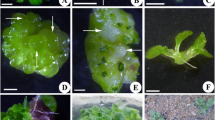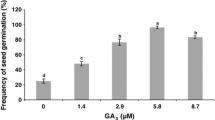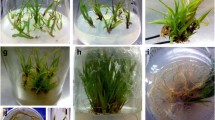Abstract
The effects of various growth regulators on morphogenesis from cocoyam tissues (Xanthosoma sagittifolium) were investigated. Calluses were initiated from shoot tip and petiole explants and proliferated on medium containing 1.36 μM dicamba. Callus production was significantly greater from petioles than from shoot tips. Thidiazuron (0.045 μM) enhanced callus production when dicamba (13.5 μM) was used, and was more favorable to petioles than shoot tips. Friable shoot tip callus was subcultured into liquid media containing either 1.36 μM dicamba alone, 1.35 μM 2,4-D + 0.46 μM kinetin or 1.36 μM dicamba + 0.46 μM kinetin to induce adventive regeneration. Tissues producing single or aggregated shoot buds were subcultured into media containing 0, 0.049 and 0.49 μM 2-isopentenyladenine where bud multiplication and shoot regeneration were observed. Bud aggregates were formed from callus in liquid cultures containing 1.36 μM dicamba, 1.36 μM dicamba + 0.46 μM kinetin or 1.35 μM 2,4-D + 0.46 μM kinetin. Shoot bud clumps which remained green produced shoots, daughter buds, and plantlets in stationary and agitated liquid media containing 0, 0.049 and 0.49 μM 2iP.
Similar content being viewed by others
References
Abo El-Nil MM & Zettler FW (1976) Callus initiation and organ differentiation from shoot tip cultures of Colocasia esculenta. Plant Sci. Lett. 6: 401–408
Acheampong E & Henshaw GG (1984) In vitro methods for cocoyam improvement. In: Terry ER, Doku EV, Arene OB & Mahungu NM (eds) Tropical Root Crops. Production and Uses in Africa. Proc. 2nd Triennial Symp., Intl. Soc. Trop. Root Crops, Africa Branch, Douala, Cameroon. Intl. Dev. Res. Center (IDRC), Ottawa, Canada, IDRC-221: 165–168
Agueguia A & Fatokun CA (1987) Pollen storage in cocoyam (Xanthosoma sagittifolium [LI Schott). Euphytica 39: 195–198
Anonymous (1991) Tropical Roots and Tubers Research Project. Fifth Annual Report. Institute of Agronomic Research, Cameroon
Asokan MP, O'Hair SK & Litz RE (1984) Rapid multiplication of Xanthosoma caracu by in vitro shoot tip culture. HaartScience 19: 885–886
Gamborg OL, Miller RA & Ojima K (1968) Nutrient requirements of soybean root cells. ExpI. Cell Res. 5: 151–158
Hartman RD (1974) Dasheen mosaic virus and other phytopathogens eliminated from Caladium, taro and cocoyam by culture of shoot tips. Phytopath. 64: 237–240
Kacker A, Bhat SR, Chandel KPS & Malik 8K (1993) Plant regeneration via somatic embryogenesis in ginger. Plant Cell, Tiss. Org. Cult. 32: 289–292
Licha M, BaeIla D, Trifiro R & Liu LJ (1982) Effect of various media on callus formation, proliferation and plantlet development in tanier (Xanthosoma spp). Phytopath. 72: 121
Lyonga SN (1980) Cocoyam production in Cameroon. Intl. Symp. Taro, Cocoyam. International Foundation of Science (IFS). Provisional Report 5
Nguyen TQ & Nguyen VU (1987) Aroid propagation by tissue culture: Shoot tip culture and propagation of Xanthosoma violaceum. HortSci. 22: 671–672
Novak FJ, Afza R, Van Duren M, Perea-Dallos M, Conger BV & Xiaolang T (1989) Somatic embryogenesis and plant regeneration in suspension cultures of dessert (AA and AAA) and cooking (ABB) bananas (Musa spp). Bio/Technology 7: 154–159
Nyman LP, Gonzales CJ & Arditti J (1983) Reversible structural changes associated with callus formation and plantlet development from aseptically cultured shoots of taro (Colocasia esculenta var antiquorum). Ann Bot 51: 278–286
Nzietchueng S (1985) Xanthosoma (macabo) et contraintes de production: cas particulier de la pourriture racinaire causé par Pythium myriotylum au Cameroun. Thèse doctorat es Sciences Naturelles, Université de Yaounde
Onokpise OU, Tambong JT, Nyochembeng L & Wutoh JG (1992) Acclimatization and flower induction of tissue culture derived cocoyam (Xanthosoma sagittifolium Schott) plant. Agronomie 12: 193–199
Pacumbaba RP, Wutoh JG, Sama AE, Tambong JT & Nyochembeng LM (1992) Isolation and pathogenicity of rhizosphere fungi of cocoyam in relation to the cocoyam root rot disease. J. Phytopath. 135: 265–273
Sabapathy S & H Nair (1995) In vitro propagation of taro, with spermine, arginine and ornithine. II. Plantlet regeneration via callus. Plant Cell Rep. 14: 520–524
Strauss MS & J Arditti (1979) Plantlet regeneration from shoot tip cultures of Xanthosoma caracu. Ann Bot 45: 209–212
Yam TW, Young JLP, Fan KPL & Arditti J (1990) Induction of callus from axillary buds of taro (Colocasia esculenta var esculenta, Araceae) and subsequent plant regeneration. Plant Cell Rep. 9: 459–462
Ziv M (1989) Enhanced shoot and cormlet proliferation in liquid cultured gladiolus buds by growth retardants. Plant Cell, Tiss. Org. Cult. 17: 101–110
Author information
Authors and Affiliations
Rights and permissions
About this article
Cite this article
Nyochembeng, L.M., Garton, S. Plant regeneration from cocoyam callus derived from shoot tips and petioles. Plant Cell, Tissue and Organ Culture 53, 127–134 (1998). https://doi.org/10.1023/A:1006084207636
Issue Date:
DOI: https://doi.org/10.1023/A:1006084207636




